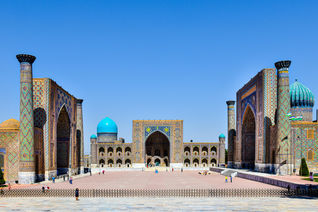Samarkand
Discover the Timeless Beauty of Samarkand
Nestled in the heart of Central Asia, Samarkand is more than just a city — it's a living testament to the splendor of ancient civilizations. With a history that spans over 2,700 years, this UNESCO World Heritage site has been a crossroads of cultures, a hub of trade, and a beacon of intellectual and artistic achievement.
A Glimpse Into History
Once the jewel of the Silk Road, Samarkand flourished as a cultural and scientific center under the reign of the mighty Timur (Tamerlane) in the 14th century. The city’s stunning architecture, rich history, and vibrant atmosphere transport visitors to another era. The glorious Registan Square, with its magnificent madrasahs, serves as the heart of this historical marvel. Every step in Samarkand is a journey through time.

.jpg)
Architectural Wonders
Samarkand’s iconic landmarks are nothing short of breathtaking. The Shah-i-Zinda, a necropolis of intricately tiled mausoleums, the awe-inspiring Bibi-Khanym Mosque, and the Ulugh Beg Observatory are just a few of the treasures waiting to be explored. These monumental structures, adorned with vibrant blue tiles and intricate mosaics, tell the stories of empires, scholars, and the unstoppable march of time.
Cultural Riches
Beyond its architectural wonders, Samarkand is alive with the sounds, flavors, and colors of a dynamic culture. Stroll through its bustling bazaars and vibrant streets, where you can sample mouthwatering plov (Uzbek pilaf), sip on sweet tea, and take in the warm hospitality of its people. The markets brim with silk, spices, and crafts, a vivid reminder of the city’s role as a trading hub.
A City of Innovation and Knowledge
Samarkand was once home to some of history's greatest minds, including the legendary astronomer Ulugh Beg and the philosopher Al-Biruni. It was a place where East met West, and where art, science, and philosophy thrived. The legacy of Samarkand’s intellectual prowess continues to inspire scholars and artists around the world.
.jpg)
The Registan, located in the heart of Samarkand, is one of the most iconic architectural masterpieces of the Silk Road. Its name means “Sandy Place,” and it served as the city’s central square for public gatherings, royal announcements, and trade. The ensemble consists of three grand madrasas: the Ulugh Beg Madrasa (1417–1420), known for its advanced astronomical studies; the Sher-Dor Madrasa (1619–1636), adorned with tiger mosaics; and the Tilya-Kori Madrasa (1646–1660), famous for its lavish gold interiors. These structures combine Islamic, Persian, and Timurid architectural styles, with intricate tilework, towering minarets, and ornate domes. Built over centuries, the Registan reflects Samarkand’s role as a center of knowledge, art, and culture. Today, it remains a symbol of Uzbekistan’s historical heritage and architectural brilliance.
The Mausoleum of Tamerlane, or Gur-e-Amir, is a masterpiece of Timurid architecture in Samarkand. Built in the early 15th century, it serves as the final resting place of Tamerlane (Amir Timur), his sons, and grandsons. The structure is distinguished by its majestic blue dome, intricate mosaics, and carved marble interiors. Originally intended for Tamerlane’s grandson, it became his own tomb after his death in 1405. The mausoleum’s design influenced later Mughal architecture, including the Taj Mahal. Today, Gur-e-Amir stands as a symbol of Tamerlane’s legacy and the grandeur of the Timurid era.
.jpg)
.jpg)
Shah-i-Zinda, one of Samarkand’s most iconic landmarks, is a necropolis dating back to the 11th century, located on the city’s southern edge. Its name, “The Living King,” refers to Kusam ibn Abbas, a cousin of Prophet Muhammad, who is said to be buried here. The complex consists of nearly 20 mausoleums built between the 11th and 15th centuries, forming a “street of tombs” that showcases the evolution of Central Asian Islamic architecture.The structures are renowned for their intricate tilework, including vivid turquoise and lapis lazuli hues, geometric patterns, and floral motifs, all characteristic of Timurid art. Shah-i-Zinda served as a burial site for Samarkand’s nobility, scholars, and artisans, with each addition reflecting the architectural advancements of its time. Highlights include the Mausoleum of Shadi Mulk Aka, the Mausoleum of Tuman Aka, and the Kusam ibn Abbas shrine.The site also holds great spiritual significance, attracting pilgrims who believe in its blessings and historical connection to Islamic heritage. Today, Shah-i-Zinda is celebrated as an unparalleled example of medieval craftsmanship and a key cultural treasure of Uzbekistan.
Shah-i-Zinda’s construction spans from the 11th to the 15th centuries, evolving into a harmonious blend of Islamic and Timurid architecture. The complex is arranged as a narrow, stepped passageway lined with mausoleums, creating an almost otherworldly atmosphere. The tombs showcase masterful craftsmanship with glazed tiles, intricate geometric patterns, floral motifs, and calligraphic inscriptions in Arabic. Notable elements include the striking cobalt blue domes and carved majolica panels, which give the complex its iconic look. Each mausoleum reflects the influence of different time periods, making Shah-i-Zinda a living museum of architectural innovation and spiritual devotion.










Address
50, Aviasozlar, 100204, Tashkent, Uzbekistan
Phone
+998-50-444-17-17
